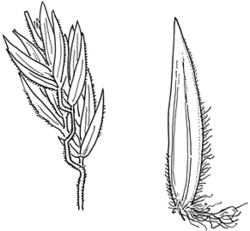Common name: Coast Tussock-grass, Blue Tussock-grass
Poa poiformis (Labill.) Druce APNI* Synonyms: Arundo poaeformis Labill. APNI*

Description: Densely tufted erect perennial to 1 m high, rarely with vertical or oblique rhizomes.
Leaves with sheath usually smooth, the lower becoming loose; ligule truncate, 0.25–1.25 mm long; blade usually strongly convolute and terete or angular-terete, mostly 0.25–1.5 mm wide.
Panicle 8–30 cm long, commonly contracted. Spikelets 2–7-flowered, compressed, 6–10 mm long. Glumes 3–5 mm long, acute to acuminate, lower 1–3-nerved, upper 3-nerved. Lemma 3–6 mm long, subacute to truncate, 5–7-nerved, hairy on the keel to c. the middle and usually on the lateral nerves and margins, the internerves usually glabrous; web usually long and copious. Palea scabrous on the keels above.
Flowering: most of year.
Distribution and occurrence: Grows along ocean foreshores and estuaries, occasionally on coastal sand dunes and cliffs, especially south-facing cliffs; south from Port Stephens.
NSW subdivisions: NC, CC, SC, LHI
Other Australian states: Vic. Tas. S.A. W.A.
Text by S. W. L. Jacobs & S. M. Hastings
Taxon concept: Flora of NSW 4 (1993)
APNI* Provides a link to the Australian Plant Name Index (hosted by the Australian National Botanic Gardens) for comprehensive bibliographic data
***The AVH map option provides a detailed interactive Australia wide distribution map drawn from collections held by all major Australian herbaria participating in the Australian Virtual Herbarium project.
|


